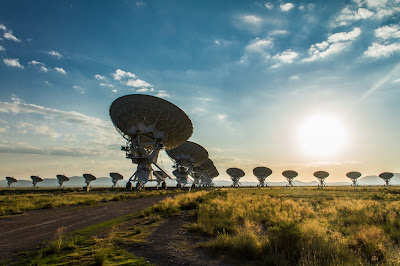We shall not cease from exploration . . .
- T. S. Eliot, "Little Gidding," Four Quartets
On a vast remote plain 7,000 feet above sea level in south central New Mexico are 27 radio antennas, each 25 meters in diameter. Constructed in the late 1970s, the antennas are known as the Very Large Array, or VLA.
The VLA conducts observations of astronomical radio frequency sources such as pulsars, quasars, black holes, and other phenomena. Though featured in the 1997 film, Contact, (click here for a cool clip) and numerous other films, the VLA is not used in the search for extraterrestrial intelligence.
The VLA antennas are arrayed in a Y formation, nine along each 13-mile long leg.
 |
| Image courtesy of Google Earth |
The antennas weigh 230 tons each, but can be moved on rail tracks by a specially-designed locomotive that also lifts them off and onto pedestals.
The antennas can thus be arranged in very broad or very tight formations, depending on the angular resolution needed for observations. Together, they act as a single antenna with a variable diameter ranging from 1200 meters to 26 miles.
The antennas can also be re-oriented to point in any direction horizontal to vertical. For a 24-second video showing a dish being re-oriented, click here.
I make a pilgrimage to the VLA every other year or so. These images were made last summer (2014) during two trips. The first visit was in July with my photo buddy, Barry Schwartz . . .

 |
| Image courtesy of Barry Schwartz |
. . . and the second, about a month later, with my younger son, Drew.
I go to the VLA for two reasons: (1) it's a great photography destination, yielding great visuals in different light, different weather every time . . .
. . . and (2) for the inspiration it provides: what complex, beautiful, majestic, awesome tools the minds of humans can conceive and build to extend our view far beyond our tiny little speck of a planet!
If you would like to see these images and more in a larger format, visit my photography website, Todos Juntos Photography, by clicking here.
Enjoy!












No comments:
Post a Comment